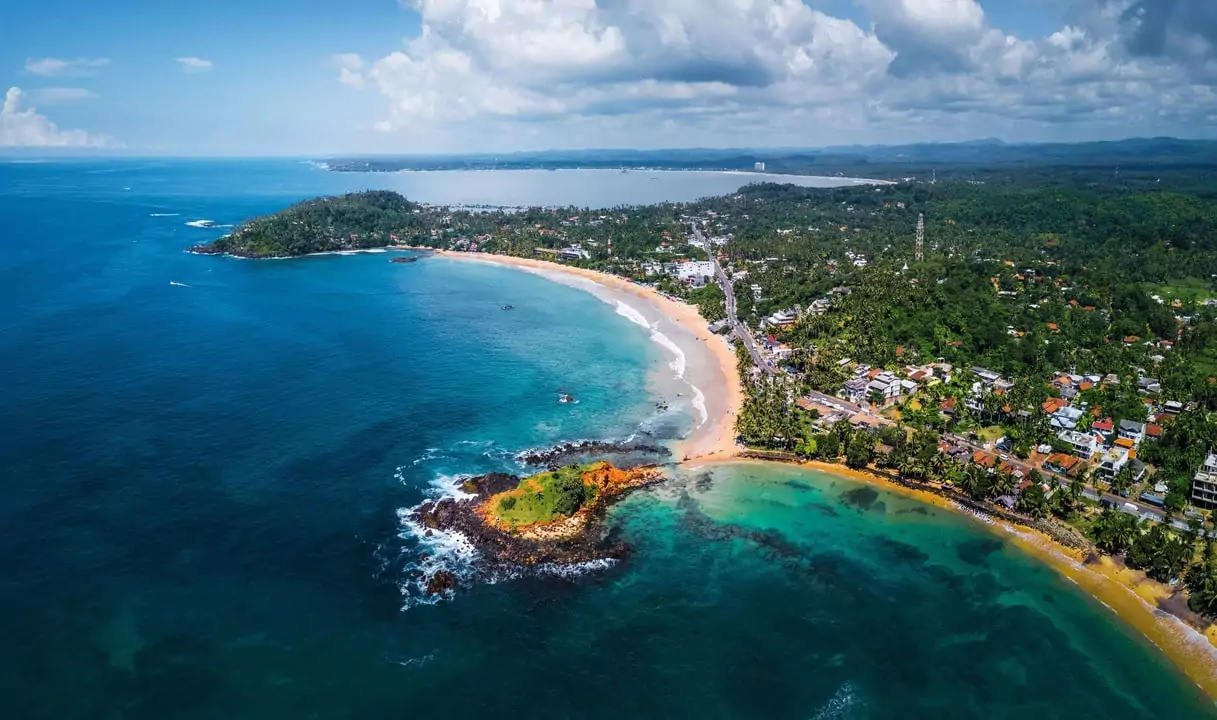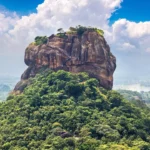Overview
Sri Lanka may be a small island in the Indian Ocean but that’s the only thing small about it. The country, formerly known as Ceylon, boasts an ancient civilization, golden sandy beaches with their swaying coconut palms, mountains, and rubber and tea plantations.
While visiting the island, you’ll see colonial architecture from the days when the Portuguese, Dutch and English ruled. You’ll see lots of elephants, some of which participate in local festivals and, if you’re lucky, perhaps a leopard or two at a wildlife sanctuary.
Arriving: Getting In
The main International Airport in Sri Lanka is Bandaranaike International Airport in Colombo. You would be booking your flight from your origin to the airport code CMB. There are direct flights to Colombo from most regions in the world, except the Americas and Africa. If you are in the European region, you can catch regular flights from Paris, Frankfurt and Zurich. Daily direct flights are available out of London. There are also several direct flights from regions in Russia, South East Asia and Australia. The best connecting flights usually fly through the middle-east and connect the entire world to Colombo on airlines such as Qatar Airways, Emirates Airlines and the likes.
To enter the country, you will likely need to obtain a visa, known as an ETA visa. This can be done on arrival, but after a long flight it will be a hassle to wait around for longer to process this and get out of the Airport. We suggest you get your visa ahead of time and obtain it online using https://eta.gov.lk/slvisa/. It will cost around $40 and will generally be processed in 24 hours, get this done in advance to save yourself the time and hassle. Also check with your GP beforehand to make sure all your vaccinations are up to date. For assistance visit our Travel Desk at the arrival lobby.
Getting Around: Transportation
There are several ways to get around the Island. Most commonly buses, trains, tuk-tuks, and private taxis are used by travellers visiting the Island. Public transportation systems aren’t the best, but is most popular with the locals and is the cheapest way to get around. Buses rarely run-on schedule and most trains are often slower and less efficient than other forms of transportation. The key thing about Sri Lanka is that your money goes a long way when converted into the local currency (Rupee). Roads around the country are in very good condition, and utilizing a private-taxi will get you the most bang for your buck in Sri Lanka. Hiring a chauffeur to drive you around is surprisingly affordable and will save you tons of time and hassle of getting around. We recommend that you book a chauffeur in advance so you can benefit from a round trip discount and save money and time. For short trips you can always haggle a tuk-tuk and get to your destination swiftly, however be direct on where you want to go and avoid detours. Always make sure to agree on a price before-hand or use one that has a built-in taxi-meter. A pro-tip is to always carry local currency in hand as most places on the island do not accept cards payment.
Food : What to Eat?
Food is usually a big appeal for any traveller visiting a new place, and there’s plenty of it in Sri Lanka. Sri Lankan cuisine is known for its Rice and Curry, which is rice accompanied by a platter of different dishes cooked in unique Sri Lankan spices, and is traditionally served on a banana leaf or a lotus leaf. Another delicacy is the Lamprais, which is rice cooked in stock with meat and vegetables then baked in a banana leaf. The most popular street food among the locals is a dish named Koththu which is a mix of roti, vegetables or meat, all cooked in a wok with Sri Lankan spices. There are plenty of options if you are a vegetarian or vegan in Sri Lanka. Authentic Sri Lankan cuisine is largely based around vegetables and coconut milk. Jackfruit is a unique delight you will find in any Sri Lankan restaurant. Being a tropical paradise there is no shortage of fresh fruits in the markets and you can be sure to grab a fresh-juice at one of the countless juice bars you will find at any given city on the Island. Also be sure to grab a King-coconut off a road side vendor to cool off on a hot-day and taste what the locals use as a natural hangover cure.
Language: Communication
The two main languages spoken in the country are Sinhala and Tamil, additionally English is very commonly spoken and widely used in official and commercial environments. You will be able to get around quite comfortably with English as most people you interact will know basic English. Street signs and billboards are also displayed in English. Ayubowan is the official greeting in Sinhala, which means Hello or Welcome and directly translates to “long-life’.
Money: Currency
The currency here is the Sri Lankan Rupee or LKR. It’s a closed currency, which means you can only get it once you land in Sri Lanka. You will have to exchange the currency you carry into Rupees in one of many certified currency exchange outlets. Make sure to talk to your travel partner to get the best daily exchange rates. Scottish or Irish Pound notes won’t be accepted so bear than in Mind. One thing to remember is that cash is much more useful than your bank card, particularly when you are in more rural areas. There are options on the Island for any budget and you will see that your money goes a long way in Sri Lanka.
Accommodation: Where to Stay
There are over 156 classified tourist hotels and 239 unclassified tourist hotels in Sri Lanka. There are ultra-luxury boutique hotels costing in the range of $1000 per night and small intimate Guest Houses for around $40 per night. The average accommodation cost in Sri Lanka ranges from: 10 USD for a hostel to 80 USD in a 3-star hotel. Price per night in a luxury 5-star hotel in Sri Lanka averages around 200 USD. There is a place for every wallet size and a pro-tip is to book with a local travel agent to get better rates than online booking platforms that usually charge large hidden fees. Talk to your travel agent about getting a package trip with transportation and take advantage of cheap package deals which are usually available at very competitive rates. This will save you loads of time and money when travelling in Sri Lanka.
Highlights: Things to do
- Galle
Galle is loved by locals and tourist alike. If you are in Sri Lanka, you should not miss out on visiting Galle and the neighbouring Unawatuna Beach. This old colonial coastal town is filled with history and beautiful architecture. With palm trees, white sand and turquoise waters, it’s easy to see why it’s one of Sri Lankas most popular beaches. There are shopping strips along the Galle Fort and Unawatuna beach for souvenirs and restaurants. Unawatuna Beach also has a buzzing night life where you are sure to catch a party along the beach on weekends.
- Yala
Sri Lanka has the best safari outside of Africa since the country has one of the highest rates of indigenous plants and animals in the world. Yala national park is a highlight of any trip to Sri Lanka. Yala is home to many endemic species and if you are looking for leopards and elephants, Yala is the best place to spot some wild ones. Take a safari early in the morning or later afternoon when they are avoiding the heat to spot these magnificent creatures in their natural habitat.
- Ella
If you are looking for stunning views and breathtaking scenery, you are guaranteed to find it in Ella. Ella has a very unique climate and an attraction than any other destination in Sri Lanka. You must really take the time to explore the areas natural beauty and ample vista points. No trip to Ella is complete without a visit to the famous Nine-arch bridge for a selfie and a hike up Little Adam’s peak to take in the breathtaking views of the waterfalls and valleys below. It’s also worth mentioning that the most iconic train journey in Sri Lanka is from Ella to Kandy which is a 6-hour train ride with magnificent views of the Sri Lankan highlands. As I mentioned earlier in the article, trains are not taken by travellers for speed and convenience so it’s all about the views. There are also options to experience the train in a shorter distance if you are taking a trip with a chauffeur driven car.
- Kandy
Kandy is known as the hill-capital of Sri Lanka. When you get to Kandy you must visit Sri Dalada Maligawa or The Temple of the Sacred tooth relic of. It’s a beautiful temple built during the era of the Kingdom of Kandy and houses a tooth which belonged to the Buddha. To enter the site, you will need to cover up appropriately and remove your shoes. The Kandy Temple is also known for the Asela Perehera Festival which is hosted annually in the month of August. When in Kandy be sure to catch a performance of the Kandyan Dance and visit a Gem Museum.
- Dambulla
Dambulla is most famous for its epic rock cave temples which is filled with huge buddha statues. Here’s what you need to know about visiting this important holy place. As with all temples guest must be appropriately dressed, covering up shoulders and legs, make sure to take off any head gear and shoes when you enter. Posing for pictures with the buddha is frowned upon as according to locals its custom to never have your back to him. If in doubt always follow the locals and do what they do. Speaking of locals while in Dambulla you will inevitably to run into a toque macaque, a type of monkey endemic to Sri Lanka. Do not leave your bags unattended as these cheeky chaps will snatch even the most well-hidden snacks in your bag.
- Sigiriya
Also in the Dambulla area is the ancient city of Sigiriya. It’s an ancient rock fortress and the remains of a palace which was built in the 5th century, on top of a rock 180 meters in height. It is one of the eight UNESCO World Heritage Sites in Sri Lanka. It is one of the most visited tourist sites in Sri Lanka. If tourist aren’t your thing and you prefer to stay away from the crowd, then you need to check out Pidurangala Rock instead. It is less well known but offers stunning views of the main attraction Sigiriya, it’s also much cheaper. Although I must say the climbs are not for the faint hearted, go around 4.30pm to make it up for Sunset.
- Polonnaruwa
The 10th Century ancient kingdom of Polonnaruwa is now divided into 2 parts, the new-town and the old-town. It is the old town which is made up of the ancient ruins of the royal city which is a Sri Lankan equivalent to the Roman forum in Italy. It’s a great day to spend the day exploring the tons of ancient tombs, temple and statues.
- Colombo
Colombo is the most populated city and the financial capital of Sri Lanka. What you need to know is that it’s a metropolitan city, it’s big and it’s busy. There’s lots to do here and you can finally start spending with your card, there’s uber to get around and plenty of fast-food joints to satisfy any craving. If fast-food isn’t your thing, not to worry, because Colombo is the best place to sample traditional Sri Lankan cuisine.






